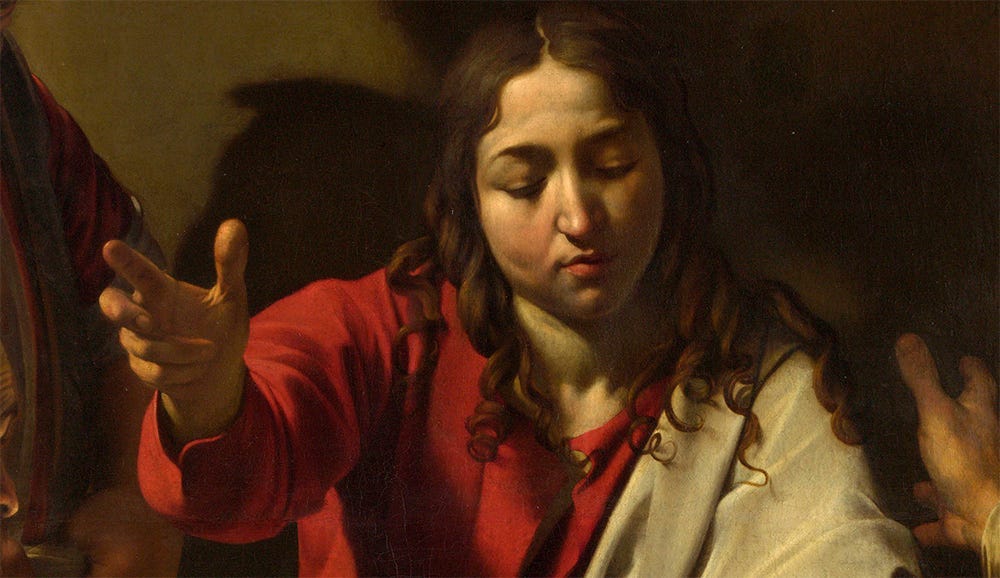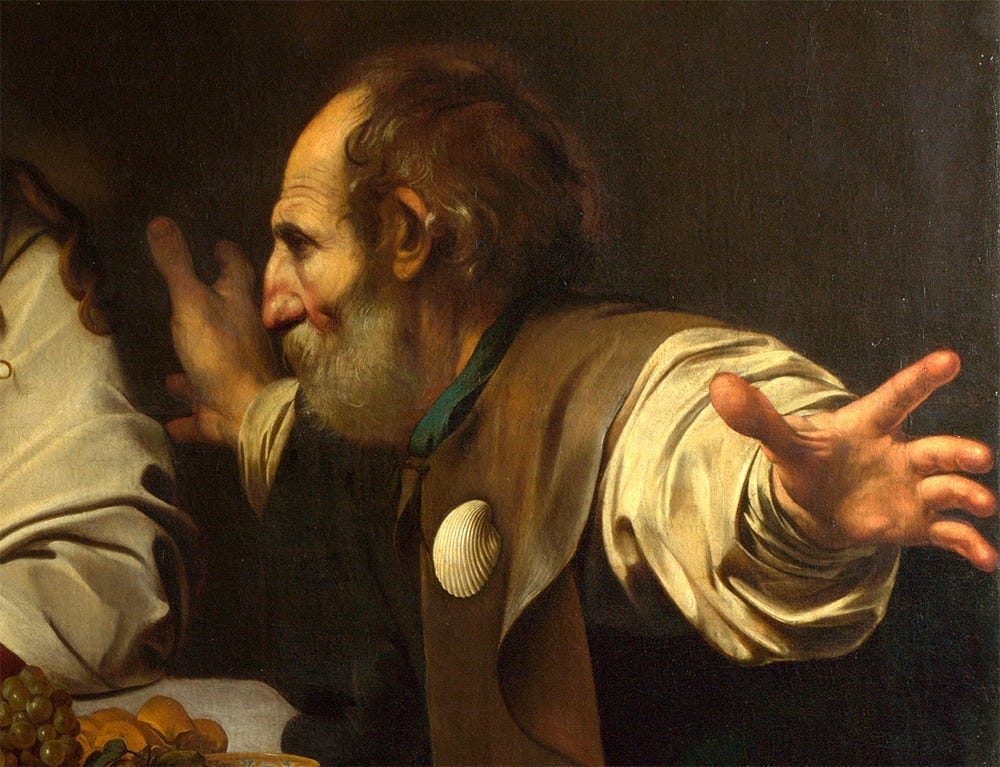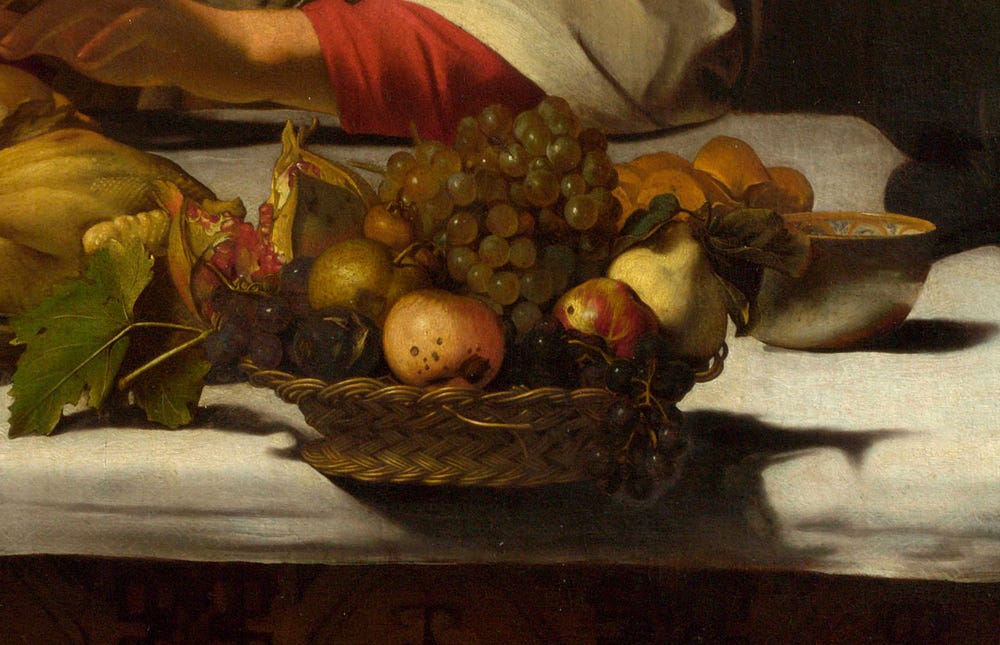The Caravaggio Painting That Reveals a Miracle
Psychological amazement in a vivid and realistic masterpiece

Dear Reader,
This gripping painting is all about capturing a moment of transformation.
Created using a blend of bold and earthy colours, overlaid with chiarascuro, Caravaggio’s The Supper at Emmaus represents both a physical change and a psychological set of responses.
The subject is a biblical scene as told in the Gospel of St. Luke: three men are sitting eating at a table when one of them reveals himself to be Christ. His two companions were not aware before, but now they see. Their faces and body language depict their reactions to Christ’s identity. There is surprise and alarm. This transformation is the central conceit of the painting and its dramatic intention.
Meanwhile, the innkeeper — stood above the table with a somewhat glazed expression — is yet to understand what is being witnessed. His face is in shadow to suggest spiritual innocence.

How does Caravaggio manage this miracle? How does the artist represent change in the frozen marks of paint?
His main device is bodily gesture, and more subtly, the intimate nature of the setting. The way the table space is open at the front allows us as viewers to partake in the scene, pulling us into the drama of the moment.
Like many of Caravaggio’s paintings, he achieves a powerful sense of tension by using light and shadow, with strong passages of crisp white scattered across the image. Giovanni Pietro Bellori, a 17th-century writer on art, described how Caravaggio “never brought his figures out into the daylight but placed them in the dark brown atmosphere of a closed room, using a high light that descended vertically over the principal parts of the bodies, while leaving the remainder in shadow, in order to give force through a strong contrast of light and dark.”
Christ is notably without his customary beard and so has a youthful quality, an allusion to his ‘changed’ form. He is plumper and red-cheeked, as if glowing from his resurrection, and performs his blessings with a graceful vigour, one hand passing over the bread, the other reaching forward into the viewer’s space. His movements impress as steady and stable; on either side of him the two companions display alternate gestures of amazement and shock.

These two disciples, still coming to terms with Jesus’s crucifixion three days before, were on their way to the town of Emmaus a few miles from Jerusalem. At the end of the day’s journey they were approached by an unknown man who they invited to take supper with them: “ ‘For evening draws on, and the day is almost over.’ So he went to stay with them. And when he had sat down with them at the table, he took bread and said the blessing; he broke the bread, and offered it to them. Then their eyes were opened, and they recognised him; and he vanished from their sight.” (Luke 24:28–32)

The disciple on the left-hand side has been identified as Cleophas. He thrusts his head forward and grips the sides of his chair with protruding elbows, as if about to stand back in disbelief.
The disciple on the right, who is believed to be St Peter, is wearing a white scallop shell, symbolic of pilgrims, and stretches his arms out in a glorious expression. Of astonishment? Happiness? However we might define his inner feelings, it is clear that this is a gesture of the moment, a reflex response to the sudden revelation.

The naturalism of his expression is extraordinary, the foreshortening of the out-thrust arm as competent as any other in Western art.
Caravaggio’s style is unmistakably earthy. His disciples are ordinary men with worn clothes and receding hairlines, almost certainly based on real-life models without any attempt at idealisation. His tendency to show apostles as dirty, ragged and unkempt was a point of criticism often levelled at Caravaggio by his contemporaries.
The basket of fruit that hovers on the table’s edge is also significant. Not only does its precarious position add a touch of present-moment tension to the scene, but the contents of the basket may also be read symbolically.

The apple at the front appears to have begun rotting: a symbol of the Temptation and of the Fall of Man. The grapes above are symbolic of the Eucharistic wine and hence the blood of Christ. The shadow that falls to the right-hand side of the fruit basket may also be interpreted as referring to Jesus’ ministry: it appears to show the silhouette of a fish, from the moment that Jesus entreated his first disciples to be “fishers of men.” In such a way, Caravaggio has used the basket of fruit not only as a still-life element in the table setting but also to underpin the meaning of the story that he paints.
This image was painted around 1601 when Caravaggio was 30 years old. Living in Rome at the time, he was enjoying unrivalled success as a powerful, dramatic realist. The Supper at Emmaus was originally commissioned by Ciriaco Mattei, an Italian nobleman of Rome and of the House of Mattei, and one of the most prolific art collectors in the city.
With great immediacy, Caravaggio fulfilled the commission with aplomb, and it remains one of his most compelling works.
I wish you well,
Chris
P.S. Upgrade if you want more stories like this…
I’m Christopher P Jones — art writer and author of the Looking at Art series of books. You can find out more at chrisjoneswrites.co.uk and my regular blog on Medium.





I’m already a subscriber and a fan..thank you, so very good! We so need more inspiration and this art does it for us, thank you.
Wonderful! Thanks.